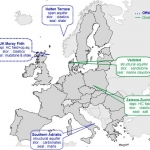
The research project coordinated by SPYRA PRIMO-POLAND Sp. z o.o. and AGH University of Science and Technology. Partners: Warsaw University of Technology and Central Mining Institute.






IRES Integrated Reservoir Exploration & Gas Extraction System for Shale Gas
IRES research project will involve the construction of effective NEW RESERVOIR ENGINNERING TOOLS FOR UNDERSTANDING OF FLOW PHENOMENA IN SHALE GAS.
These tools will be: a new in-situ monitoring of natural gas reservoirs based on Raman spectroscopy and "fiber optic" technology. These technologies enable to quick determination of composition of natural gas from shale formations, reservoir fluids characterization, monitoring nano-tracers and determination of basic reservoir parameters. Data obtained using this technology will help to construct classical numerical models of geological structures. The novelty of this approach will apply to the use of mathematical methods for solving the inverse problem with the statistical analysis of the reliability of hypotheses. Built numerical models of structures will be used to build exploitation simulation models of unconventional gas reservoirs. Due to the specificity of unconventional reservoirs, which requires new tools for modeling, analysis of the exploitation process and gas field management the new methodology will be developed to create fast and accurate surrogate reservoir models (SRM) to facilitate the analysis of uncertainty and decision-making processes. There are used the elements of statistical models and fuzzy logic algorithms. Single-well surrogate reservoir model (SRM model) will be constructed which will enable to do a large number of simulations in a short time, enabling the operator to respond to any signals coming from the exploitation well in real time. Also, it will be developed the model of the possible impact of rocks and fluids, and assess the extent of injected fracturing fluid and the possibility of fluid retention in the reservoir as a result of reaction with the rock and capillary effects. Built numerical reservoir models, surrogate simulation models of exploitation (SRM model) and model of fracturing fluid impact will enable the development of effective procedures for assessment of modeling final reservoir exploitation EUR (Estimated Ultimate Recovery) with analytical and probabilistic models with elements of fuzzy logic and statistical methods based on reservoir parameters , stimulation system and exploitation data.
Concept of all work-packages:
WP1
In-situ monitoring of reservoir parameters and physical processes of gas reservoirs in shale formations.
WP2
The development of effective procedures for modeling of natural gas reservoirs in shale formations by solution of inverse problem for determining an important parameters of the model.
WP3
The specification of unconventional reservoirs requires new tools for modeling and analysis of the exploitation and management of the reservoir. Methodology will be developed to create fast and accurate surrogate models to facilitate the analysis of uncertainty and decision-making processes.
WP4
This WP is connected with modeling process of flowback period and subsequent regular gas production from the well will be completed trough the construction of model of the potential interaction of rocks and fluids, and assess the extent of injected fluid and the possibility of holding a fluid in reservoir as a result of reaction with the rock and capillary interactions. This model will be used to build the analytical model of predictions post-reaction fluid extraction.
WP5
The development of effective procedures for assessment modeling of reservoir exploitation EUR (Estimated Ultimate Recovery) with analytical and probabilistic models with using of fuzzy logic algorithms and statistical methods based on reservoir parameters, system stimulation parameters and exploitation data.

The research project named “Thermomechanical analysis of underground gas storage facility operation” focuses on the development of a numerical model of natural gas storage cavern.
The research project named “Thermomechanical analysis of underground gas storage facility operation” focuses on the development of a numerical model of natural gas storage cavern. The model will include decrease of rock mass temperature during cavern leaching and gas temperature changes during compression and expansion. Until now, the obtained results indicate that in the case of seasonal storage facilities, impact of these effects on convergence of a cavern is important, but lower than would be expected, due to theshift of temperature extremesin rock salt massif.

 SiteChar is a European research project about CO2 storage. SiteChar started in January 2011 and will last 3 years. Central to the Sitechar project is examining the technical, economic and societal requirements for a company to be allowed to store CO2 underground
SiteChar is a European research project about CO2 storage. SiteChar started in January 2011 and will last 3 years. Central to the Sitechar project is examining the technical, economic and societal requirements for a company to be allowed to store CO2 underground
Who is involved in SiteChar?
Coordinated by IFP Energies Nouvelles, SiteChar brings together another sixteen partners from research, industry and the consultancy sector ten EU countries:
Who is paying for SiteChar?
Who will benefit from SiteChar?
The objective of SiteChar is to provide a methodology for the preparation of CO2 storage license applications, incorporating all the technical and economic data, as well as social acceptability. This methodology is being designed for further use by storage site operators and regulatory bodies.
What will SiteChar do for me?
Public acceptability of CO2 capture and storage is a very important issue. SiteChar addresses this issue in various ways and welcomes your input. More information about our activities can be found on the Public Participation page.




